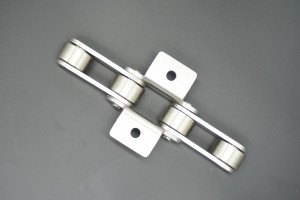The section where the two rollers are connected with the chain plate is a section.
The inner link plate and the sleeve, the outer link plate and the pin are connected with interference fits respectively, which are called inner and outer link. The section connecting the two rollers and the chain plate is one section, and the distance between the centers of the two rollers is called the pitch.
The length of the chain is represented by the number of chain links Lp. The number of chain links is preferably an even number, so that the inner and outer chain plates can be connected when the chain is jointed. Cotter pins or spring locks can be used at the joints. If the number of chain links is odd, the transition chain link must be used at the joint. When the chain is loaded, the transition chain link not only bears tensile force, but also bears additional bending load, which should be avoided as much as possible.
Introduction to transmission chain
According to the structure, the transmission chain can be divided into roller chain, toothed chain and other types, among which the roller chain is the most widely used. The structure of the roller chain is shown in the figure, which is composed of the inner chain plate 1, the outer chain plate 2, the pin shaft 3, the sleeve 4 and the roller 5.
Among them, the inner chain plate and the sleeve, the outer chain plate and the pin shaft are fixedly connected by interference fit, which are called inner and outer chain links; the rollers and the sleeve, and the sleeve and the pin shaft are clearance fits.
When the inner and outer chain plates are relatively deflected, the sleeve can rotate freely around the pin shaft. The roller is looped on the sleeve, and when working, the roller rolls along the tooth profile of the sprocket. Reduces gear tooth wear. The main wear of the chain occurs at the interface between the pin and the bushing.
Therefore, there should be a small gap between the inner and outer chain plates so that the lubricating oil can penetrate into the friction surface. The chain plate is generally made into an “8″ shape, so that each of its cross-sections has nearly equal tensile strength, and also reduces the mass of the chain and the inertial force during movement.
Post time: Aug-31-2023

